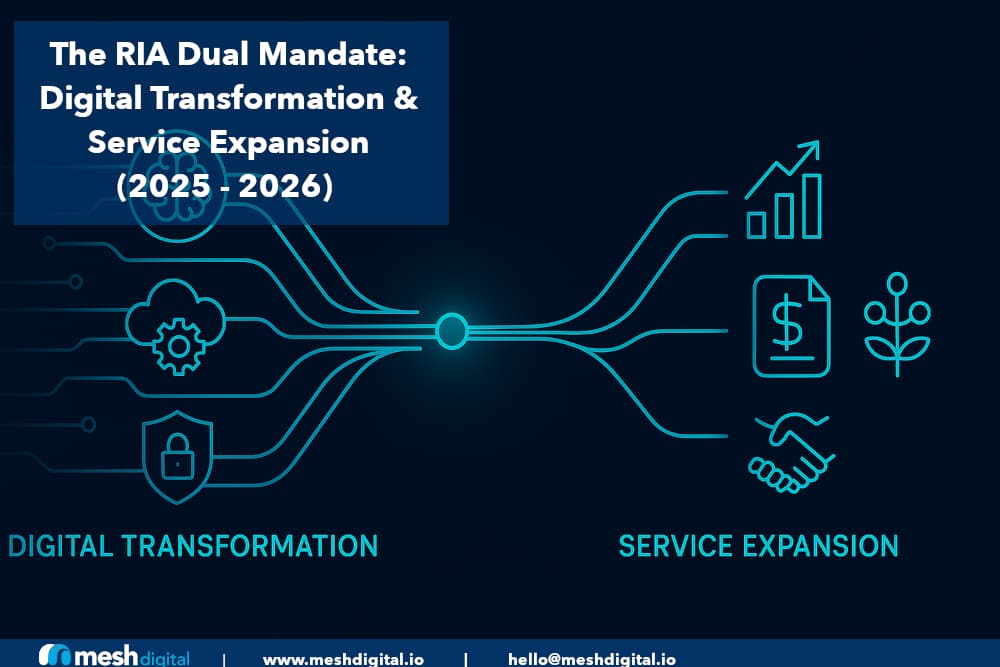The RIA Dual Mandate: Navigating Digital Transformation and Service Expansion for Enduring Growth (2025–2026) Part I: Digital Transformation
Part I shows how future ready RIAs turn digital transformation, AI-driven workflows, unified data, and client-centric portals into a scalable backbone that trims costs, boosts advisor capacity, and sets the stage for richer, tech-enabled growth.

Executive Summary
The Registered Investment Advisor (RIA) industry is entering a defining era. With consolidation surging and 2025 projected to be a record year for M&A activity, the message is clear: growth isn’t just about assets anymore. Leading firms are “growing by design,” not by default, by mastering a dual mandate: accelerating digital transformation while expanding into a more holistic advisory model.
This first part of our two-part series focuses on the digital side of that equation. Technology is no longer simply about automation or efficiency; it’s the connective tissue that links data, people, and insight to create differentiated client experiences and scalable growth. The question facing RIA leaders isn’t whether to invest in digital, but how to do it in a way that delivers both operational clarity and strategic agility.
The Digital Imperative: From Tech Stack to Strategic Ecosystem
RIAs are evolving beyond software implementations to reimagined digital technology as a strategic platform. The digital imperative today is about eliminating friction, enabling scale, supporting service innovation, and delivering deeply personalized experiences, not just building more tools.
Operational Efficiency as Growth Catalyst
The best-run RIAs treat operational efficiency as a foundation for growth. Rather than layering new tools on top of legacy systems, firms are stepping back to redesign their architecture, simplify workflows, and enable faster execution. Streamlined operations not only reduce cost per client, but frees up capital, advisor time and leadership cycles for high-impact strategic efforts.
At Mesh Digital, we help RIAs shift from legacy complexity to strategic design. That means simplifying and modernizing the technology foundations, so systems talk to each other cleanly, quickly, and cost effectively eliminating the friction that slows decision-making and service delivery. But it also means rethinking the organization and operating models as well. Realigning roles, responsibilities, and team structures to better support cross-functional collaboration and client-centric execution. As firms grow, legacy processes often remain patched together; we help to unwind that complexity, modernizing not just tech platforms, but how work gets done across the firm.
AI-Powered Personalization
Artificial intelligence (AI) is rapidly shifting from concept to capability in the wealth management space. For RIAs, the value of AI isn’t in flashy promises, it’s in how it helps firms operate more efficiently and deliver deeper, more personalized client experiences.
At its best, AI reduces the noise and friction in daily operations, allowing advisors to focus more energy on what truly drives value: building trust, delivering insight, and guiding clients through complex financial decisions. Where AI is creating value in RIA firms include:
- Client Engagement: Sentiment detection, life-event tracking, and personalized outreach triggers
- Advisor Productivity: CRM updates, meeting summaries, and automated task lists
- Risk Management: Document reconciliation, audit trail integrity, and real-time compliance surveillance
- Strategic Alignment: AI-supported M&A fit assessments and operational due diligence
Despite its promise of AI, many RIAs find themselves stalled at implementation. In fact, more than half report integration challenges, particularly when introducing AI into legacy systems that were never designed for automation or data sharing.
The issue isn’t a lack of tools; it’s the absence of AI models trained for the special needs of the financial services industry. As well as, missing cohesive strategies and blueprints to support successful business outcomes. To unlock real value, firms need more than a software rollout, they need a thoughtful roadmap that connects AI investments to business outcomes. That includes:
- Specialty-trained models (e.g., Industry SLMs): Securing or training finance-specific language models to improve accuracy, ensure regulatory fidelity, and reduce hallucination risk.
- Strategic alignment: Ensuring AI pilots are tied to business goals, not side experiments.
- Process re-architecture: Rethinking workflows to remove redundant steps and embed automation meaningfully.
- Organizational change management: Equipping teams across advisory, operations, compliance, client service, and technology to understand, trust, and adopt AI-enhanced processes.
Without these elements, AI risks becoming another disconnected point solution, one that adds complexity instead of reducing it. With them, it becomes a powerful enabler of scale, personalization, and high-value growth
The Client Portal as Digital Living Room
Modern client portals are no longer file cabinets. They’re engagement hubs where clients interact with their advisors, view a consolidated financial picture, and act on real-time insights. When well-executed, they increase trust, streamline communication, and elevate the advisor-client relationship at scale. Yet today, most firms continue to rely on fragmented operating models and systems, leading to “swivel-chair” manual workflows and disjointed client and advisor experiences.
Data as a Strategic Asset
RIAs are stewards of immense volumes of client, portfolio, and planning data, yet most still struggle to harness it as a lever for growth. Treating data as a strategic asset means more than housing it securely; it means activating it to drive timely, insight-rich decision making across the firm.
When unified and governed effectively, data allows RIAs to move from reactive service to predictive engagement. Leading firms are analyzing behavioral patterns, engagement frequency, and financial events to:
- Fragility Management: Flag at-risk clients before attrition happens
- Holistic Wealth & Values-Aligned Planning: Uncover tax optimization or philanthropic planning opportunities
- Client Engagement & Lifecycle Marketing: Build segmented, personalized content strategies based on real needs, not assumptions
Achieving this level of intelligence requires a deliberate data strategy, governance model, and modern infrastructure to eliminate silos between platforms like CRM, portfolio management, financial planning, and compliance systems. Data unification isn’t just about efficiency, it’s foundational to cybersecurity, resilience, AI readiness, and scalable personalization. When structured and activated correctly, data becomes an always-on advantage: continuously enhancing advisor effectiveness, client experience, and strategic agility.
Conclusion: Setting the Foundation for Part II
Digital transformation is not a standalone initiative, it's the foundation that enables everything else. From efficiency and scale to personalization, improved cyber security, and client trust. Technology now shapes the operating model of every future-ready RIA. But digital transformation is only half the story.
In Part II, we'll explore the second pillar of the dual mandate: service expansion. We'll examine how leading firms are embracing the "Family CFO" model, democratizing access to alternatives, and expanding their value proposition beyond investment advice, supported by digital capabilities. Stay tuned for how this evolution is redefining what it means to grow by design.
